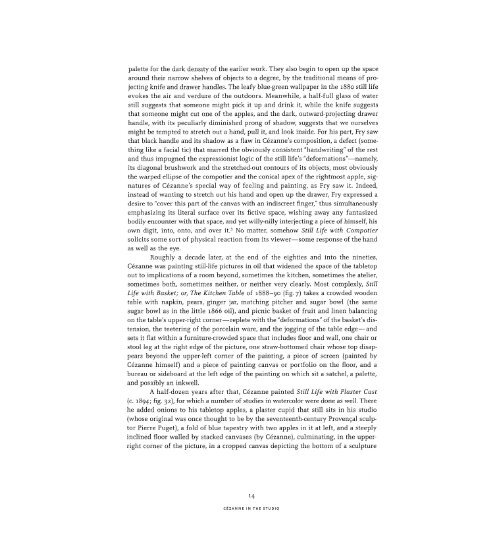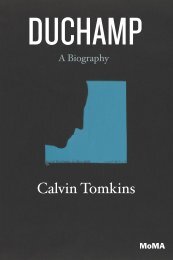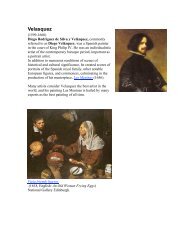Still Life in Watercolors
qbj8dgc
qbj8dgc
- No tags were found...
You also want an ePaper? Increase the reach of your titles
YUMPU automatically turns print PDFs into web optimized ePapers that Google loves.
palette for the dark density of the earlier work. They also beg<strong>in</strong> to open up the space<br />
around their narrow shelves of objects to a degree, by the traditional means of project<strong>in</strong>g<br />
knife and drawer handles. The leafy blue-green wallpaper <strong>in</strong> the 1880 still life<br />
evokes the air and verdure of the outdoors. Meanwhile, a half-full glass of water<br />
still suggests that someone might pick it up and dr<strong>in</strong>k it, while the knife suggests<br />
that someone might cut one of the apples, and the dark, outward-project<strong>in</strong>g drawer<br />
handle, with its peculiarly dim<strong>in</strong>ished prong of shadow, suggests that we ourselves<br />
might be tempted to stretch out a hand, pull it, and look <strong>in</strong>side. For his part, Fry saw<br />
that black handle and its shadow as a flaw <strong>in</strong> Cezanne's composition, a defect (someth<strong>in</strong>g<br />
like a facial tic) that marred the obviously consistent "handwrit<strong>in</strong>g" of the rest<br />
and thus impugned the expressionist logic of the still life's "deformations"—namely,<br />
its diagonal brushwork and the stretched-out contours of its objects, most obviously<br />
the warped ellipse of the compotier and the conical apex of the rightmost apple, signatures<br />
of Cezanne's special way of feel<strong>in</strong>g and pa<strong>in</strong>t<strong>in</strong>g, as Fry saw it. Indeed,<br />
<strong>in</strong>stead of want<strong>in</strong>g to stretch out his hand and open up the drawer, Fry expressed a<br />
desire to "cover this part of the canvas with an <strong>in</strong>discreet f<strong>in</strong>ger," thus simultaneously<br />
emphasiz<strong>in</strong>g its literal surface over its fictive space, wish<strong>in</strong>g away any fantasized<br />
bodily encounter with that space, and yet willy-nilly <strong>in</strong>terject<strong>in</strong>g a piece of himself, his<br />
own digit, <strong>in</strong>to, onto, and over it. 3 No matter, somehow <strong>Still</strong> <strong>Life</strong> with Compotier<br />
solicits some sort of physical reaction from its viewer—some response of the hand<br />
as well as the eye.<br />
Roughly a decade later, at the end of the eighties and <strong>in</strong>to the n<strong>in</strong>eties,<br />
Cezanne was pa<strong>in</strong>t<strong>in</strong>g still-life pictures <strong>in</strong> oil that widened the space of the tabletop<br />
out to implications of a room beyond, sometimes the kitchen, sometimes the atelier,<br />
sometimes both, sometimes neither, or neither very clearly. Most complexly, <strong>Still</strong><br />
<strong>Life</strong> with Basket; or, The Kitchen Table of 1888-90 (fig. 7) takes a crowded wooden<br />
table with napk<strong>in</strong>, pears, g<strong>in</strong>ger jar, match<strong>in</strong>g pitcher and sugar bowl (the same<br />
sugar bowl as <strong>in</strong> the little 1866 oil), and picnic basket of fruit and l<strong>in</strong>en balanc<strong>in</strong>g<br />
on the table's upper-right corner—replete with the "deformations" of the basket's distension,<br />
the teeter<strong>in</strong>g of the porcela<strong>in</strong> ware, and the jogg<strong>in</strong>g of the table edge—and<br />
sets it flat with<strong>in</strong> a furniture-crowded space that <strong>in</strong>cludes floor and wall, one chair or<br />
stool leg at the right edge of the picture, one straw-bottomed chair whose top disappears<br />
beyond the upper-left corner of the pa<strong>in</strong>t<strong>in</strong>g, a piece of screen (pa<strong>in</strong>ted by<br />
Cezanne himself) and a piece of pa<strong>in</strong>t<strong>in</strong>g canvas or portfolio on the floor, and a<br />
bureau or sideboard at the left edge of the pa<strong>in</strong>t<strong>in</strong>g on which sit a satchel, a palette,<br />
and possibly an <strong>in</strong>kwell.<br />
A half-dozen years after that, Cezanne pa<strong>in</strong>ted <strong>Still</strong> <strong>Life</strong> with Plaster Cast<br />
(c. 1894; fig. 32), for which a number of studies <strong>in</strong> watercolor were done as well. There<br />
he added onions to his tabletop apples, a plaster cupid that still sits <strong>in</strong> his studio<br />
(whose orig<strong>in</strong>al was once thought to be by the seventeenth-century Provencal sculptor<br />
Pierre Puget), a fold of blue tapestry with two apples <strong>in</strong> it at left, and a steeply<br />
<strong>in</strong>cl<strong>in</strong>ed floor walled by stacked canvases (by Cezanne), culm<strong>in</strong>at<strong>in</strong>g, <strong>in</strong> the upperright<br />
corner of the picture, <strong>in</strong> a cropped canvas depict<strong>in</strong>g the bottom of a sculpture<br />
14<br />
CEZANNE IN THE STUDIO




